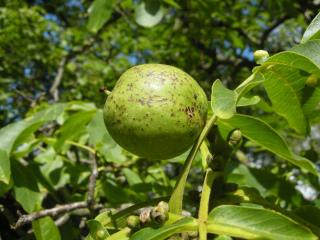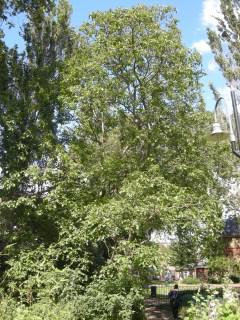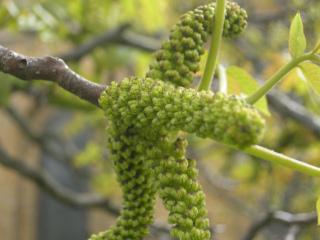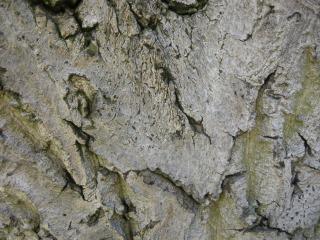
Juglans regia Fruit (05/07/2012, London)
Position: Full sun
Flowering period: Late spring
Soil: Moist, well drained
Eventual Height: 20m
Eventual Spread: 20m
Hardiness: 4b - 9b
Family: Juglandaceae
Juglans regia is a slow growing, long lived, deciduous tree with a short trunk and broad crown. Its dark green, waxy leaves are alternate, odd-pinnate with up to 9 leaflets with entire margins and up to 40cm long. Its leaves are fragrant when crushed. Its twigs contain air spaces and appear hollow when snapped. Its trunk may achieve a diameter of 2m. Its bark is silver/ gray with broad fissures. Its flowers are monoecious. Its green male flowers being drooping catkins which are up to 10cm long and appear in clusters of up to 5. Its green female flowers are small and insignificant, are terminal and appear in groups of up to five. Its fruit are green, up to 6cm across when ripe in autumn and contain edible walnuts.

Juglans regia (05/07/2012, London)
Juglans regia, commonly known as the Persian Walnut, English Walnut and Common Walnut, is native to a region from south east Europe to south west china. This tree exhibits great genetic diversity from region to region. This tree has a long history in cultivation for it edible fruit dating back to at least the fourth century BC. It was introduced into the UK by the Romans. Other plants will often not grow within the canopy spread of this tree due to the presence of jugalone in thee fallen leaves which inhibit the growth of other plants.
The etymological root of the binomial name Juglans is from the classical Latin name for this tree. Regia is from the Latin meaning ‘ regal’

Juglans regia male flower (11/05/2012, London)
The landscape architect may find Juglans regia useful as a large fruiting tree, it may be suitable for a community garden where space allows. It is also suitable as a parkland tree.
Ecologically, J. regia is attractive to some mammals who eat its nuts.
The Royal Horticultural Society has given J. regia their prestigious Award of Garden Merit in 1993.

Juglans regia Leaf (05/07/2012, London)
J. regia prefers moist, humus rich, deep, well-drained soils. It tolerates most pH of soil. It will not tolerate water logged soils.
Juglans regia requires little maintenance. Necessary pruning should be carried out in summer to early autumn while the tree is still in full leaf. Suckers should be removed as the appear.

Juglans regia Bark (05/07/2012, London)

